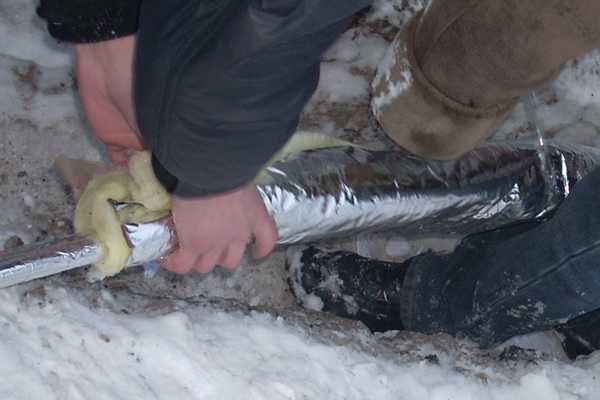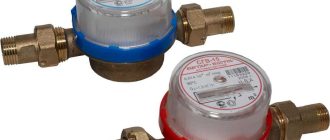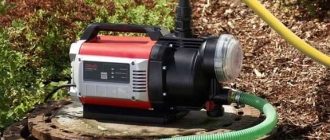Winter plumbing in the dacha with your own hands can be done in two ways:
- bury it so that it does not freeze (below the frost depth);
- to lay shallow, but with insulation and/or heating.
Insulation of water pipes – an event not so much requiring money as labor – digging trenches, laying pipes, wrapping them, throwing and compacting the soil, all this – time and considerable effort. But the result is the presence of water in the house at any time of the year.
Contents of the article
Laying pipes below the frost depth
This method is reasonable to use if the ground freezes in winter no deeper than 170 cm. A trench is dug from the well or borehole, the bottom of which is 10-20 cm below this value. At the bottom is poured sand (10-15 cm) pipes are laid in a protective casing (corrugated sleeve), then covered with earth.
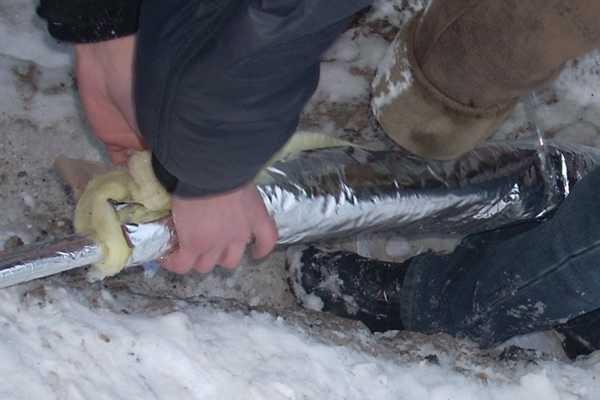
This is the easiest way to make winter plumbing in the dacha, but it is not the best, although the cheapest. Its main disadvantage – if repairs are necessary, you will have to dig again, and to the full depth. And since it is difficult to determine the place of leaks in this method of laying water pipes, there will be a lot of work.
To repair was as little as possible, the connection points of pipes should be as few as possible. Ideally, they should not be at all. If the distance from the water source to the dacha is greater, make connections carefully, achieving perfect tightness. It is the joints that flow most often.
The choice of material for pipes in this case is not the easiest task. On the one hand, there is a lot of pressure from above, so you need a strong material, and that is steel. But steel laid in the ground will actively corrode, especially if the ground water is high. The problem can be solved by well priming and painting the entire surface of the pipes. And it is desirable to use thick-walled pipes – they will last longer.
The second option – polymer or metal-polymer pipes. They are not subject to corrosion, but they need to be protected from pressure – lay in a protective corrugated sleeve.
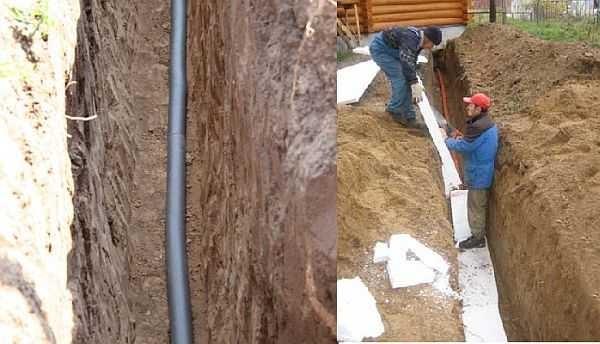
One more thing. The depth of ground freezing in the region is determined for the last 10 years – its average values are calculated. But firstly, there are periodically very cold and snowy winters, and the ground freezes deeper. Secondly, this value – the average for the region and does not take into account the conditions of the site. It is possible that exactly on your piece of land the freezing may be greater. All this is said to the fact that when laying pipes, it is better still to insulate them, lay on top of sheets of foam or polystyrene foam, as in the photo on the right, or lay in insulation, as on the left.
Perhaps you will be interested in reading “How to make an auto irrigation”.
Insulation of the pipeline
Making water supply of a private house from a well and a well pipeline can be laid at a very shallow depth – 40-50 cm – it is quite enough. Only lay pipes in such a shallow trench should be insulated. If you want to do everything thoroughly, you lay the bottom and sides of the trench with some building material – bricks or building blocks. Everything is covered with slabs on top.
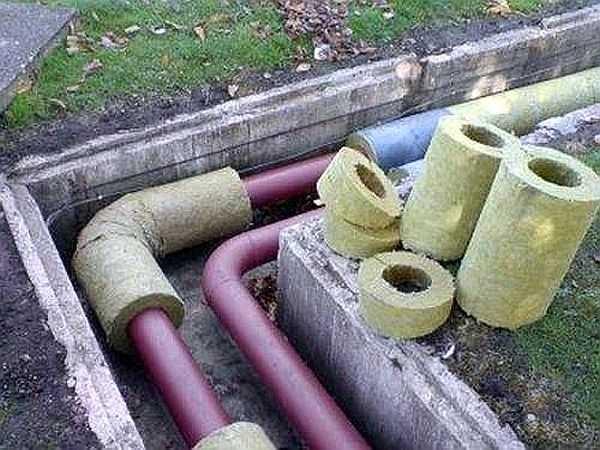
If desired, you can fill in the soil and plant annuals – if necessary, the soil can be easily removed and free access to the pipeline is ensured.
Insulation for water pipes
Two types of insulation can be used:
- special energy-saving shells molded in the form of pipes, they are also called “shell for pipes”;
- Rolled material – ordinary insulation in the form of rolls, which is used for walls, roofing, etc.
Thermal insulation for pipes in the form of a shell is made of the following materials:
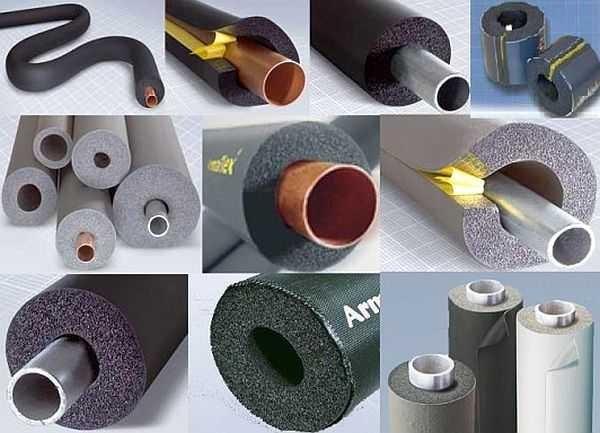
Mineral wool – glass wool and rock wool – have one significant disadvantage: they are hygroscopic. By absorbing water they lose most of their insulating properties. After drying they recover only partially. And another very unpleasant moment, if the wet mineral wool freezes, it turns into cinderblocks. To prevent this from happening, these materials require careful waterproofing. If you can not guarantee the absence of moisture, it is better to use another material.
How to make drip irrigation systems for greenhouses and vegetable gardens with their own hands is written here. About manufacturers of ready-made kits for drip irrigation article here.
Heating
Planning the device winter plumbing, you need to keep in mind that insulation only helps to reduce heat loss, but heating can not. And if at some point the frost will be stronger, the pipe will freeze. Particularly problematic in this sense, the section of the pipe outlet from the underground sewer into the house, even if heated. All the same, the ground near the foundation is often cold, and it is in this area that problems most often arise.
If you do not want to freeze your plumbing, do heating the pipe. To do this, use a heating cable or heating plates – depending on the diameter of the pipes and the required heating power. Cables can be laid lengthwise or spiraled.
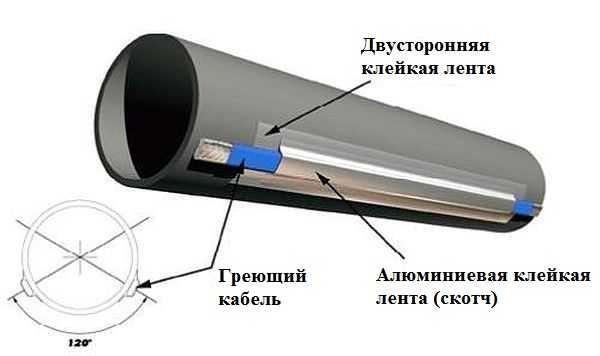
Heating cable is good for everything, but it is not so rare that we have a power outage for a few days. What happens to the piping then? The water will freeze and can burst the pipes. And repair work in the middle of winter is not the most pleasant thing to do. That’s why they combine several methods – and the heating cable is laid, and on it insulation. This method is optimal and in terms of minimizing costs: under the insulation heating cable will spend a minimum of electricity.
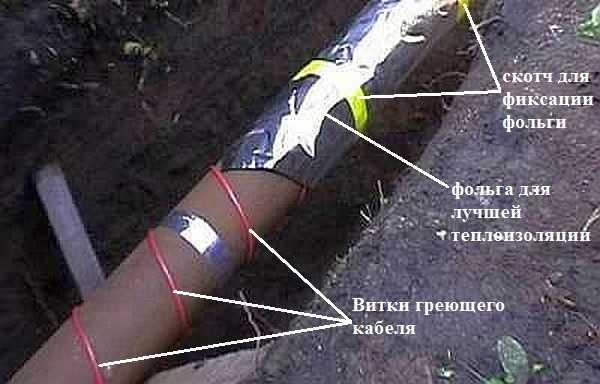
Laying a winter water pipe in the dacha can be done with the use of this type of thermal insulation, as in the video (or you can take the idea and do something similar with your own hands).
The development of the scheme of laying a water pipe in the dacha is described here.
Winter plumbing in the dacha: new technologies in insulation
There is an interesting option, polymer flexible pipe, insulated at the factory. On top of the insulator there is a layer of waterproofing, and along the pipe there is a channel for laying a heating cable. Such pipes are called non-freezing pipeline or insulated pipe. For example, even in northern regions to make a winter water pipeline in the dacha on the surface can be made with the help of pipes IZOPROFLEX-ARKTIK.

Operating temperature – up to -40°C, working pressure – from 1.0 to 1.6 MPa, diameter of pressure pipe – from 25 mm to 110 mm. They can be laid in a channel or on the surface. They are flexible, supplied in coils of the required length, which minimizes the number of joints.
There is still a new way to insulate winter water pipes in the countryside – liquid thermal insulation or thermal insulation paint. It can be applied to the already installed water pipe, which can be a good solution.

